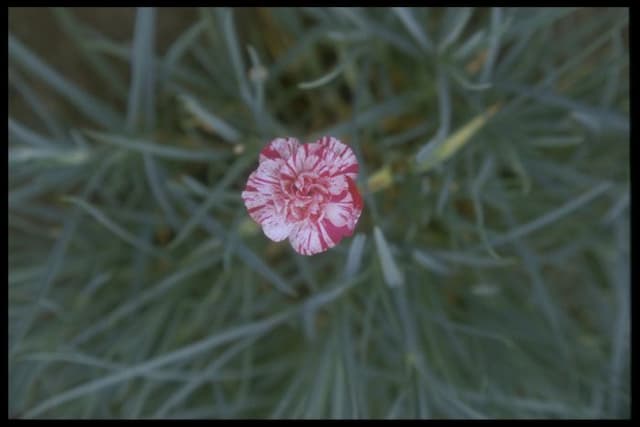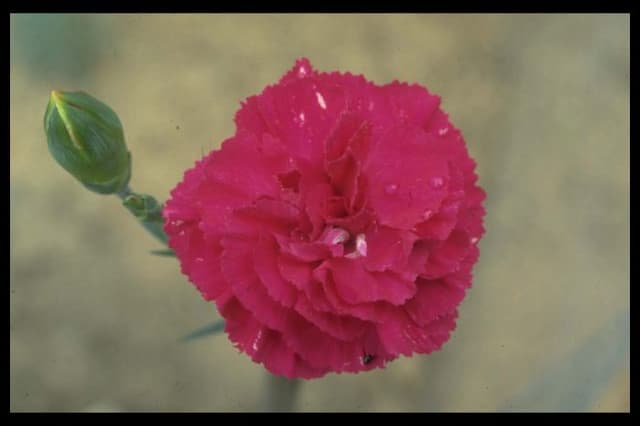Carnation Dianthus 'Moulin Rouge' (p)

ABOUT
Dianthus 'Moulin Rouge' is a vibrant and attractively colored flowering plant. It is distinctly known for its lush, bright green foliage that forms a dense and compact mound. The leaves are typically slender and pointed, adding a fine texture to the plant's overall appearance. The most striking feature of 'Moulin Rouge' is its flowers, which are often a deep crimson or velvety red, reminiscent of the red light district in Paris after which it is named. These blossoms exhibit a frilled or serrated edge, contributing to their ornamental appeal. Each flower flaunts a pattern of lighter and darker shades, sometimes with contrasting eyes or a deeper hued center, that captivate the onlooker. The flowers are usually borne on sturdy stems that rise above the foliage, creating an alluring display of color that is hard to miss when in bloom. The plant exudes a sweet, clove-like fragrance that is particularly strong in the early morning and evening, adding an additional layer of sensory delight to gardens or landscapes where it is grown.
About this plant
 Names
NamesFamily
Caryophyllaceae
Synonyms
Moulin Rouge Carnation, Moulin Rouge Pinks
Common names
Dianthus 'Moulin Rouge'
 Toxicity
ToxicityTo humans
Carnations, like the Dianthus 'Moulin Rouge', are not considered toxic to humans. They do not typically cause severe symptoms of poisoning if ingested. However, some people may experience mild gastrointestinal discomfort or allergic reactions if they have sensitivities to the plant.
To pets
Carnations, including the variety Dianthus 'Moulin Rouge', are also generally non-toxic to pets. Ingestion may lead to mild gastrointestinal upset in some animals, but serious poisoning is unlikely. If a pet exhibits symptoms like vomiting or diarrhea after ingesting this plant, it's advisable to consult a veterinarian.
 Characteristics
CharacteristicsLife cycle
Perennials
Foliage type
Evergreen
Color of leaves
Blue-green
Flower color
Red
Height
1 foot (30 cm)
Spread
1 foot (30 cm)
Plant type
Herb
Hardiness zones
7
Native area
Europe
Benefits
 General Benefits
General Benefits- Aesthetic Appeal: Dianthus 'Moulin Rouge', commonly known as Carnation, adds color and beauty to gardens with its deep red, velvety flowers and distinctive, pleasant fragrance.
- Pollinator Attraction: The bright blossoms attract bees, butterflies, and other beneficial pollinators, helping to support local ecosystems.
- Long Blooming Period: Carnations often have a long flowering season, which provides visual interest in the garden for an extended period.
- Low Maintenance: Once established, Carnations are relatively low maintenance, requiring minimal care beyond occasional watering and deadheading to promote further blooming.
- Versatility: This plant can be used in various landscape settings including borders, rock gardens, and containers, providing flexibility in garden design.
- Cut Flower Use: Carnations are popular as cut flowers due to their durability and lasting beauty in floral arrangements.
- Drought Tolerance: They are known to have good drought tolerance, making them suitable for xeriscaping and water-efficient gardening.
- Cold Hardy: Carnations are capable of withstanding cooler temperatures, making them appropriate for a range of climates.
 Medical Properties
Medical PropertiesThis plant is not used for medical purposes.
 Air-purifying Qualities
Air-purifying QualitiesThis plant is not specifically known for air purifying qualities.
 Other Uses
Other Uses- Dianthus 'Moulin Rouge', commonly known as Carnation, can be used as a natural dye for fabrics, giving them a subtle pink hue derived from the flowers.
- The petals of Carnations can be crystallized with egg whites and sugar to create elegant edible decorations for desserts.
- Dried Carnation petals can serve as a natural pest repellent in gardens, particularly effective against ants.
- Carnation flowers are often used in potpourri blends for their lasting fragrance and vibrant color.
- The plant's sturdy stems make Carnations suitable for crafting homemade floral wreaths and garlands.
- Carnation petals can be added to bath salts or bombs for a touch of luxury and a pleasant scent.
- Pressed Carnation flowers can be framed or used in decorative resin crafts such as coasters, bookmarks, or jewelry.
- Whole Carnation blooms are sometimes used in large-scale floral art installations due to their visual impact and variety of colors.
- Used in perfumery, Carnation essential oil is cherished for its rich, spicy aroma and can be found in many fragrance compositions.
- The distinctive scent of Carnations can be infused into candles or homemade soaps, adding a personal and fragrant touch to home products.
Interesting Facts
 Feng Shui
Feng ShuiCarnation is not used in Feng Shui practice.
 Zodiac Sign Compitability
Zodiac Sign CompitabilityCarnation is not used in astrology practice.
 Plant Symbolism
Plant Symbolism- Love: Dianthus flowers are often associated with love due to their vibrant colors and sweet fragrance, portraying deep emotional connections.
- Boldness: The 'Moulin Rouge' variety, with its striking red hues, represents boldness and the audacity to stand out.
- Passion: The name 'Moulin Rouge' conjures images of the famous Parisian cabaret, implying a symbol of passion and vibrant nightlife.
- Admiration: Gifting Dianthus can signify admiration for someone's bravery or uniqueness, similar to the uncommon beauty of this flower.
- Divine Favor: In historical contexts, Dianthus was believed to be the flower of the gods, symbolizing their approval or blessing.
 Water
WaterCarnations, like the Dianthus 'Moulin Rouge', prefer soil that is consistently moist but well-drained. Water the plant when the top inch of soil feels dry to the touch. Generally, this means watering about once a week, but this can vary depending on temperature and humidity levels. Apply water directly to the base of the plant to avoid wetting the foliage, which can lead to fungal diseases. Depending on the size of the plant and weather conditions, you might need about 1-2 gallons of water each time.
 Light
LightCarnations require full sunlight to flourish, so the Dianthus 'Moulin Rouge' should be placed in a spot where it receives at least six hours of direct sunlight per day. An east or south-facing location is ideal for these plants to ensure they get the ample light needed for vigorous growth and bloom production.
 Temperature
TemperatureCarnations are hardy to various temperatures; the Dianthus 'Moulin Rouge' can tolerate a range from about 40°F to 85°F. However, they thrive best in cooler conditions, between 60°F and 70°F, during the daytime. Avoid exposing the plant to temperatures below freezing, as frost can damage the foliage and flowers.
 Pruning
PruningCarnations, including the Dianthus 'Moulin Rouge', should be pruned to encourage bushier growth and more flowers. Deadheading, or removing spent flowers, promotes further blooming. Cut back the stems by one-third after the first flush of blooms usually in late summer to maintain plant vigor. Pruning is also an opportunity to shape the plant and remove any dead or diseased stems.
 Cleaning
CleaningAs needed
 Soil
SoilCarnations prefer well-draining, loamy soil with a pH of 6.0 to 7.5, so a mix of two-thirds potting soil to one-third sand or perlite is ideal to maintain proper drainage and aeration. Adding organic compost can also enrich the soil.
 Repotting
RepottingCarnations should typically be repotted every one to two years to refresh the soil and provide room for growth. This cycle can be adjusted depending on the growth rate and the size of the container.
 Humidity & Misting
Humidity & MistingCarnations thrive best in moderate humidity levels; too high humidity can encourage fungal diseases. Aim for a range of 40-60% humidity for optimal growth.
 Suitable locations
Suitable locationsIndoor
Place carnations near a sunny window and ensure moderate humidity.
Outdoor
Choose a sunny spot, protect from extreme winds, and ensure well-draining soil.
Hardiness zone
3-9 USDA
 Life cycle
Life cycleThe life of Dianthus 'Moulin Rouge', also known as 'Moulin Rouge' carnation, begins with seed germination, typically in the spring, where soil temperature and moisture levels trigger the growth of embryonic plants. Seedlings emerge and establish a small rosette of leaves at ground level, while developing a root system. As the plant matures, stems elongate, and foliage becomes more abundant, leading up to the flowering stage, which is marked by the formation of distinctive deep red, fringed flowers with a strong, pleasant fragrance. After pollination, which is often aided by insects attracted to the flowers for their nectar, the plant sets seed, completing its reproductive cycle. The 'Moulin Rouge' carnation is a perennial plant, so it will enter a period of dormancy in the winter, reducing its above-ground activity, only to resume growth and repeat the cycle in the following spring. In absence of extreme conditions, this cycle will continue for several years as the plant grows and potentially spreads within its growing area.
 Propogation
PropogationPropogation time
Spring to Summer
Dianthus 'Moulin Rouge', commonly known as Sweet William, is mostly propagated through seed sowing. The best time to sow Sweet William seeds is late spring to early summer, as the plant requires a period of cold stratification to facilitate germination. To propagate, collect seeds from a mature plant or purchase them, then sprinkle the seeds evenly over a well-drained seed starting mix in a tray or pot. Press the seeds gently into the soil but do not cover them, as they need light to germinate. Keep the soil moist but not waterlogged, and place the tray in a bright spot without direct sunlight. Germination usually occurs in two to three weeks at temperatures between 65 and 75 degrees Fahrenheit (18 to 24 degrees Celsius). Once seedlings have developed a few true leaves, they can be thinned out and eventually transplanted to their final growing location.






![Pink [Coconut Sundae]](/_next/image?url=https%3A%2F%2Fplants-admin.emdemapps.com%2Fimages%2Fplants%2F%2Fimages%2F604b5d09d4fd1.png&w=640&q=75)


